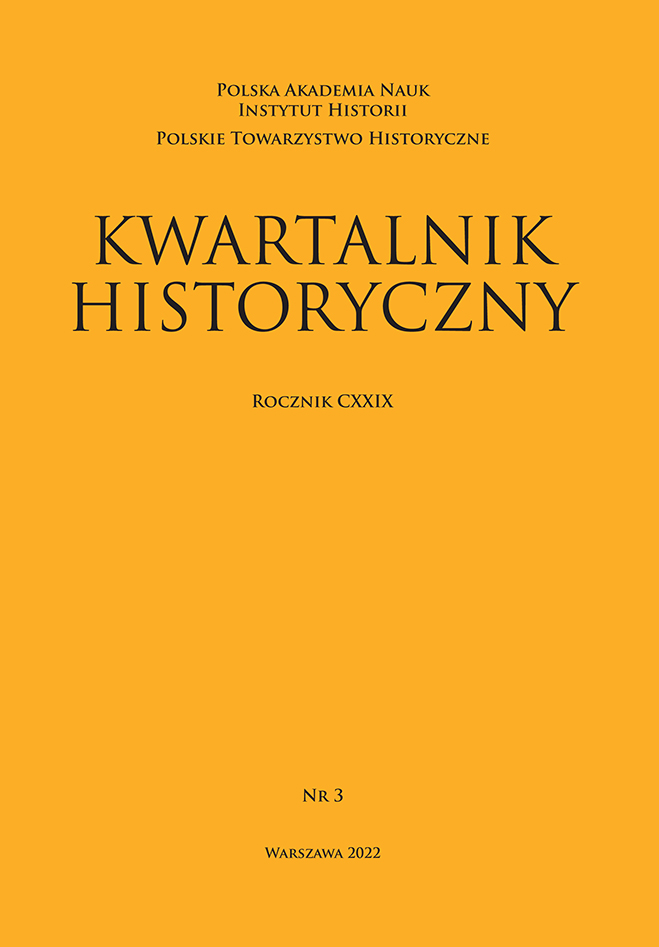Tam, gdzie zwierzę stawało się mięsem. Sposób traktowania zwierząt, warunki produkcji i nadużycia w zakładach mięsnych w Polsce w latach pięćdziesiątych i sześćdziesiątych XX wieku
DOI:
https://doi.org/10.12775/KH.2022.129.3.03Palabras clave
zakłady mięsne, mięso, nadużycia gospodarcze, stosunek do zwierząt, studia nad zwierzętamiResumen
Artykuł zawiera próbę analizy nieprawidłowości w funkcjonowaniu zakładów mięsnych w Polsce w latach pięćdziesiątych i sześćdziesiątych XX w., w tym cierpień zwierząt, które tam trafiały. Został oparty głównie na dokumentacji przechowywanej w Archiwum Akt Nowych (zwłaszcza w zespołach Najwyższej Izby Kontroli i Ministerstwa Kontroli Państwowej). Przeprowadzane badania zostały skoncentrowane na takich kwestiach jak sposób traktowania zwierząt w gospodarstwach rolnych, w punktach skupu i transporcie do zakładów mięsnych oraz w tych zakładach. Przedstawiono również ustalenia dotyczące nadużyć dokonywanych przez ich pracowników oraz złych warunków technicznych i higieniczno-sanitarnych tam panujących.
Citas
Człowiek w relacji do zwierząt, roślin i maszyn w kulturze, t. 1: Aspekt posthumanistyczny i transhumanistyczny, t. 2: Od humanizmu do posthumanizmu, red. Justyna Tymieniecka-Suchanek, Wydawnictwo Uniwersytetu Śląskiego, Katowice 2014.
Jarosz Dariusz, Obrazy okrucieństwa. Wstęp do badań nad traktowaniem bydła i trzody chlewnej w Polsce Ludowej na przełomie lat pięćdziesiątych i sześćdziesiątych XX w., „Roczniki Dziejów Społecznych i Gospodarczych” 80, 2019, s. 369–384.
Jarosz Dariusz, Reakcje społeczne na niedobory mięsa w Polsce w latach 1945–1989 (zarys problematyki), „Polska 1944/45–1989. Studia i Materiały” 7, 2006, s. 223–266.
Jarosz Dariusz, The Enemy and the Victim. Stray Dogs in Poland, 1945–70 (Discourses and Actions), „Acta Poloniae Historica” 120, 2019, s. 113–136.
Jarosz Dariusz, Zwierzęta jako przedmiot opresji w Polsce w latach 1945–1970. W poszukiwaniu głównych pól badawczych, „Polska 1944/45–1989. Studia i Materiały” 19, 2021, s. 33–56.
Jarosz Dariusz, Pasztor Maria, Afera mięsna. Fakty i konteksty, Centrum Edukacji Europejskiej, Toruń 2004.
Jarosz Dariusz, Pasztor Maria, An Attempt at a History of Meat in People’s Poland, „Acta Poloniae Historica” 95, 2007, s. 139–187.
Jarosz Dariusz, Pasztor Maria, Z badań nad stosunkiem władz Polski Ludowej do niedoborów mięsa, „Roczniki Dziejów Społecznych i Gospodarczych” 65, 2005, s. 229–268.
Jarzębowska Gabriela, Podążaj za szczurem. Od nekropolityki do teorii międzygatunkowej kohabitacji, „Praktyka Teoretyczna” 23, 2017, 1, s. 305–323.
Jarzębowska Gabriela, Retoryka deratyzacji w PRL. Od czystki etnicznej i politycznej do czystki gatunkowej, „Teksty Drugie” 2018, 2, s. 120–137.
Kochanowski Jerzy, Tylnymi drzwiami. „Czarny rynek” w Polsce 1944–1989, Neriton, IH UW, Warszawa 2010.
Landau-Czajka Anna, Koty w społeczeństwie II Rzeczypospolitej, Neriton, Warszawa 2021.
Plach Eva, Dogs and Dog Breeding in Interwar Poland, „Canadian Slavonic Papers” 60, 2018, 3–4, s. 471–496.
Plach Eva, Mad Dogs and Animal Protectionists. Rabies in Interwar Poland, „Canadian Slavonic Papers” 55, 2013, 3–4, s. 391–416.
Plach Eva, Ritual Slaughter and Animal Welfare in Interwar Poland, „East European Jewish Affairs” 45, 2015, 1, s. 1–25.
Zwierzęta i ich ludzie. Zmierzch antropocentrycznego paradygmatu, red. Anna Barcz, Dorota Łagodzka, Instytut Badań Literackich PAN, Warszawa 2015.
Descargas
Publicado
Cómo citar
Número
Sección
Licencia

Esta obra está bajo una licencia internacional Creative Commons Atribución-SinDerivadas 4.0.
Stats
Number of views and downloads: 554
Number of citations: 0



